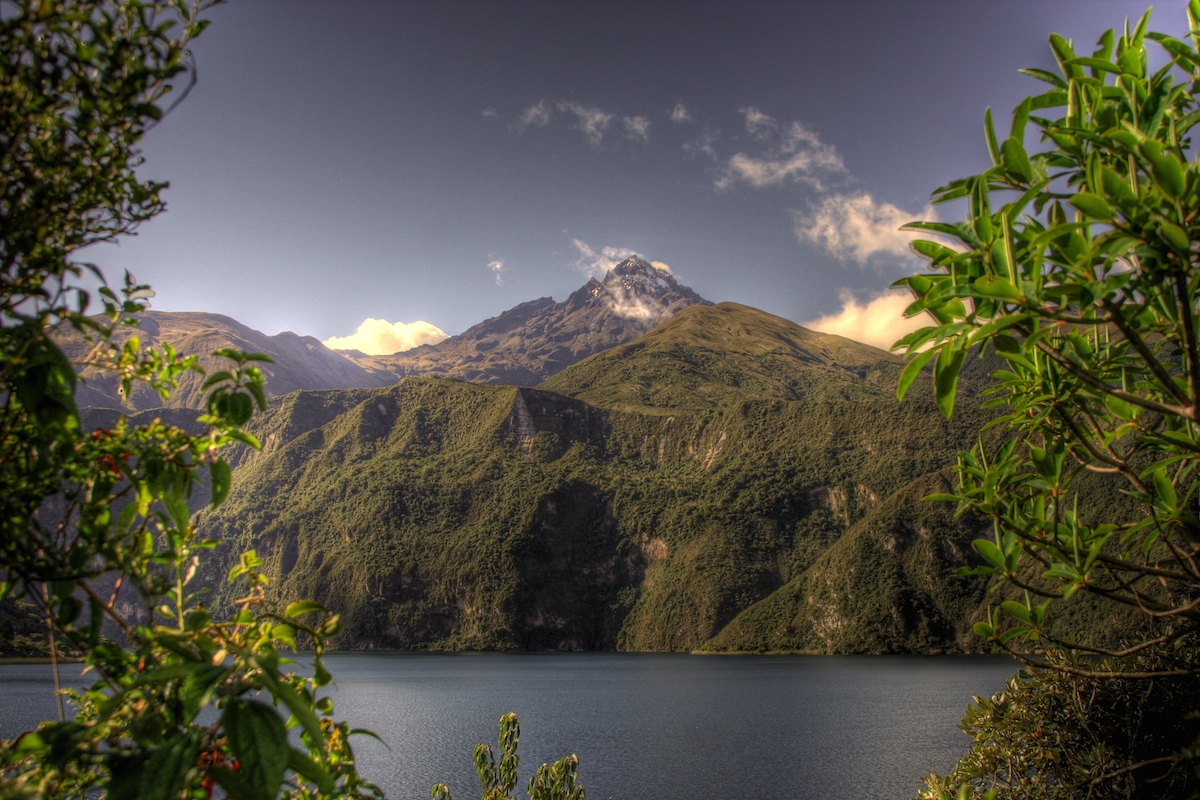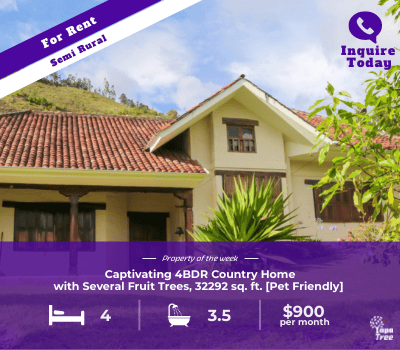Photo by Kevin Labianco.
Sometimes the beauty of a place and its people just captures your soul. My partner Stacey and I felt that about Cotacachi, Ecuador. Being from North Carolina, home to the famous Blue Ridge Mountains and Appalachian Trail, I confess I am drawn to mountain towns – they feel solid and substantial and expansive and freeing all at the same time. And, in my experience, the people living there often reflect and honor that connection with earth and sky.
Cotacachi is a town of about 10,000 people north of Quito, about 1.5-2 hours away by car, and is known for its fine leather products. Many expats have moved to Cotacachi in recent years, and we had heard that it was lovely — a small town wedged between two volcanoes with day temperatures about 70-75 degrees Fahrenheit. On one side of the town is ‘Papa Imbabura’ Volcano and on the other side is ‘Mama Cotacachi.’ When rain comes to the valley to water the crops, the indigenous peoples say it is because ‘Papa’ and ‘Mama’ are making love.
The town is simple and clean, with one big central park and cathedral. Any way you roam, you run into beautiful farmland just outside of the town limits, with volcanoes as a backdrop. One of our favorite things to do was to wake up in the morning, pick a direction and just start walking. More than a few times on our morning treks we encountered riders on beautiful horses cantering down dirt roads, the horses sometimes doing fancy steps. We learned later that there are a few special times during the year when people bring out their horses and show how well-trained and high-stepping they really are.
Most of the old colonial homes in the heart of town have been torn down and replaced with simple, contemporary buildings. Occasionally, we would find some secret gardens and old Spanish architecture and yet the primary appeal of Cotacachi is its peaceful atmosphere and beautiful setting. There are some lovely murals around the main park, plenty of excellent musicians who just show up and play, a mercado where we had the best hornado (pulled pork) of our lives, and a very sweet and well-tended cemetery on the outskirts of town. The locals describe their town as muy tranquilo (very peaceful) and are always willing to stop and chat.
It was here in Cotacachi that we had the chance to get to know many Ecuadorians, including several members of various indigenous groups. More often than not, the people on the streets of Cotacachi were indigenous, colorfully dressed in long skirts and embroidered shirts with glossy black braided hair for men & women alike. We stayed with an Ecuadorian family in their small hotel (La Cuadra) and were absorbed into their family without question — cooking meals together, playing with kids, etc. There were two young women who worked as housekeepers — Bertha and Susanna — and we especially enjoyed laughing with them. We would recommend Jairo, who happens to speak excellent English, and his family’s hotel to anyone traveling to the area.
We loved the friendliness of the people in Cotacachi and witnessed (again) the hardworking ethic of Ecuadorians — indigenous women braiding ropes with feet and hands, men creating traditional adobe walls, Bertha and Susanna flipping furniture upside down to make sure every surface was clean. The gentle receptivity of the locals and their overall openheartedness were best displayed in how they treated people who were hungry or disabled in some way. An elderly woman could show up with a bowl around mealtimes at a local restaurant, and the restaurant would invite her in or bring out food to her. A developmentally disabled young man had a job directing traffic in Cotacachi (and there’s really not much traffic to direct). There was no shaming or blaming or pitying, just a willingness to accept and be open to what (and who) the day might bring.
Lake Cuicocha
Cotacachi is close to Lake Cuicocha, which is a dormant volcano with a lake inside the crater. Lake Cuicocha translates as ‘Guinea Pig Lake’; there are two small islands that popped up in the middle of the crater after it filled with water, and the locals thought they looked like small guinea pigs (called cuy in Spanish). The lake is officially inside a small park with a small restaurant and information center on site. You can even take a boat trip out to the ‘guinea pigs.’ There is also an 8-mile hike around the crater, and we decided to do the hike.
The views of the lake were stunning. One thing we have learned about hiking in the Andes is that the trails are very deceptive — it looks as if you need only about 15 minutes to get to a certain point and then an hour later you’re almost there. The trail was well-traveled; however, it was extremely narrow and steep in some places and rocky and very uneven in other spots.
It took us about 5 hours to hike the crater, and when we got down to the bottom, still fairly early in the afternoon, there were very few cars and no taxis, so we started hiking out of the park towards the main road to see if we could find a taxi. We stumbled upon some local guides who were with a group of German students (they had passed us earlier on the trail). We asked if they were headed back to Cotacachi and they said ‘no, but we can give you a lift to Quiroga and you can catch a bus.’ We hopped in the back of a muddy pickup with 4 German students and bounced along to the tiny town of Quiroga, where we caught the 25-cent bus back to Cotacachi and promptly celebrated the day with some ice cream and roasted chicken.
Travel Tips
Airlines: Air travel inside Ecuador is pretty inexpensive. You can fly from Cuenca to Quito for $100-$150 (two people) and then took a taxi/private driver to Cotacachi (find them at the airport or right outside). Rates range $50-65.
Buses: The bus from Cuenca to Quito takes about 8-10 hours, depending on the exact bus you choose, and will cost about $12. Then it’s another 2 hours to Cotacachi, which ends up being about 4 hours on the bus for $3.
Getting around in Cotacachi: The town itself is small and very walkable. Taxis are available and cost about the same as they do in Cuenca ($1.40-$1.75 per ride). You can get private drivers/taxis (or just about anyone driving a pickup) to take you to popular spots such as Lake Cuicocha, usually for about an hour’s worth of time ($5-$10).
Other things to see & do: Cotacachi is close to the towns of Otavalo, where South America’s largest outdoor market is held on Saturdays, and Ibarra, a lovely colonial town also known as the White City. A bus to Otavalo costs 35 cents and takes about 15 minutes, while the bus to Ibarra costs 50 cents and takes about 30 minutes. You’re also close to Peguche Waterfall if you’re headed towards Otavalo; the waterfall plays an important part in indigenous rituals surrounding the Inti Raymi festival.
Food & Other Practical Stuff: There are several small restaurants in Cotacachi, along with local tiendas and the town’s mercado (the big market day is Sunday), so you can pick up necessary items without much trouble. Locals sometimes travel to Ibarra for major shopping because there are larger stores in the bigger town. There are several good lavanderías that will wash, dry and fold your clothes, all based on poundage and usually inexpensive ($4-$5). There are a few ATMs in town; however, don’t plan on using large bills during your visit — local stores don’t like to handle bills bigger than $20.





















2 Responses
We lived in Quito from 2010-2014, but every time we went to Cotachachi, I told my husband we should move there! I, too, really loved that town; it just felt right! We lived in central Quito, in the commercial sector (Inaquito) and loved it, but there is certainly something very special about Cotachachi. We returned to the U.S. for a specific medical diagnosis, which I have received, but part of us will always be in Ecuador! Mary Jane Bryan, ex-ex-pat! By the way, my first book, a contemporary romance, will be released Nov. 4, 2016. Please share this with everyone on your FB Timeline to support me plus enjoy an excellent book! My new website is http://maryjanenovels.wix.com/home (below) and my author e-mail is [email protected]. These will be in paperback and eBook format. Thanks for your patience. The waiting is the hard part! PLEASE SHARE THIS ON YOUR Facebook TIMELINE AND ASK THEM TO SHARE FURTHER!
A lovely description of Cotacachi; I have one very minor correction: the Otavalo market is open every day, it’s just that Saturday is the biggest day. Wednesday is second largest. But for those just passing through, you can go any day.